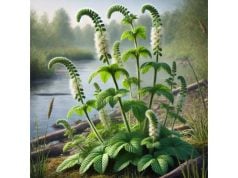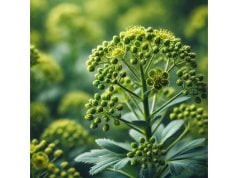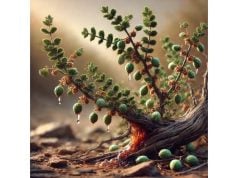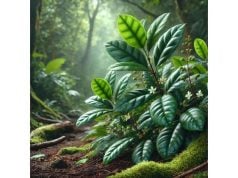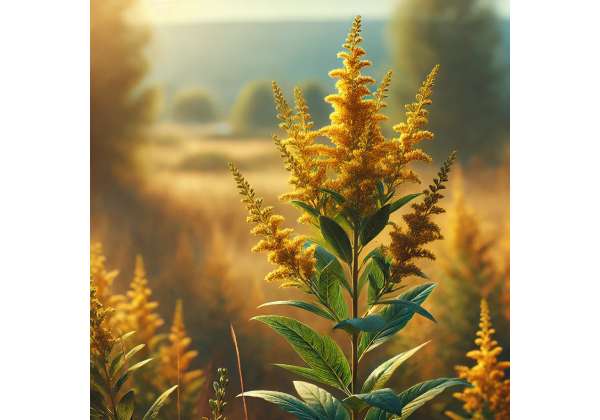
Golden Rod stands out for its brilliant yellow flowers that illuminate fields and gardens late in the season. Long prized in folk traditions, this herb is celebrated for its potential to support urinary health, soothe inflammation, and assist in wound care. Although once dismissed as a mere garden weed or allergy trigger, Golden Rod now garners interest from herbalists and researchers exploring its possible diuretic and antioxidant applications. In this guide, you’ll discover how to identify Golden Rod, the active compounds believed to produce its effects, the many ways it can be utilized safely, and the most recent scientific findings on this vibrant herb.
Table of Contents
- Plant Overview and Identifying Traits
- Active Ingredients and Chemical Profile
- Potential Health Gains and Main Properties
- Practical Applications, Dosage, and Safety
- Recent Studies and Noteworthy Research
- FAQ
Plant Overview and Identifying Traits
Golden Rod, known botanically under the genus Solidago, encompasses more than 100 species found primarily in North America and parts of Europe. Adorned with bright yellow flower clusters, this herb has captured attention for its visually striking presence in meadows, roadsides, and home gardens. Beyond its aesthetic value, it also holds a longstanding position in various herbal traditions.
Taxonomy and Classification
- Family: Asteraceae (the daisy or composite family)
- Genus: Solidago
- Notable Species: Solidago canadensis (Canada goldenrod), Solidago virgaurea (European goldenrod), Solidago gigantea (Giant goldenrod)
Across these species, slight differences in leaf shape or flower arrangement may appear, but their signature hue and composite blooms typically remain consistent.
Physical Characteristics
- Flowers: Golden Rod produces dense clusters of tiny golden-yellow florets arranged on branching stems, often shaped like feathery plumes. The blooms appear in mid-to-late summer and can last into early fall, offering bursts of color when many other plants have faded.
- Leaves: The leaves generally alternate along the stem, typically lanceolate (spear-shaped) and serrated on the edges. In many species, the leaves measure about 5–15 cm long, with a rough or fuzzy texture.
- Height: Depending on the species and growing conditions, Golden Rod can range from roughly 30 cm (1 foot) in dwarf varieties up to 2 meters (over 6 feet) in taller forms like Giant goldenrod.
- Root System: Many species develop rhizomes or creeping roots, allowing them to spread. This trait can occasionally turn Golden Rod into an invasive presence in gardens if not controlled.
Natural Habitat and Growing Requirements
- Geographic Distribution: While Solidago is primarily native to North America, some species are indigenous to Europe, and other continents have experienced introductions by horticultural enthusiasts.
- Soil Preference: Golden Rod adapts to a variety of soils, from sandy loam to clay, as long as adequate drainage is available.
- Light Needs: Prefers full sun to partial shade. Maximum flowering typically occurs with direct sunlight for several hours per day.
- Watering: Most Golden Rod species exhibit moderate drought tolerance once established, though consistent moisture supports more robust growth and vibrant blooms.
- Temperature Tolerance: These plants are generally hardy, thriving in temperate climates with cold winters and warm summers.
Distinguishing Golden Rod from Ragweed
Golden Rod is sometimes unfairly blamed for late-summer allergies caused by ragweed pollen. Ragweed pollen is wind-borne, while Golden Rod’s heavier pollen is typically insect-pollinated and not a common allergen. Nonetheless, the plants’ simultaneous flowering periods and superficial similarities have confused many casual observers, giving Golden Rod a reputation it usually does not deserve.
Cultural and Historical Context
Historically, Golden Rod has deep ties to indigenous and European herbal traditions, used for concerns ranging from kidney support to dressing wounds. American colonists reportedly made “Liberty Tea” from Golden Rod leaves following the Boston Tea Party. In modern times, artisans value its golden dye, while gardeners see it as a pollinator-friendly addition to wildflower landscapes.
Basic Growing Tips for the Home Gardener
- Propagation: Sow seeds in late autumn or very early spring, or divide established clumps in spring.
- Maintenance: Remove spent flower heads to encourage a neater appearance or to prevent excessive reseeding. Some gardeners allow seed heads to stand, providing food for birds.
- Invasiveness: Consider containing aggressive species with edging or by planting in large pots, especially if you want to avoid takeover of garden beds.
Golden Rod’s botanical distinctiveness, adaptability, and pollinator appeal have earned it a well-deserved spotlight. Understanding these identifying traits serves as a foundation for diving deeper into its active compounds and potential health benefits.
Active Ingredients and Chemical Profile
Golden Rod’s therapeutic reputation in traditional medicine stems from its assortment of phytochemicals. These include flavonoids, saponins, and other biologically active components that may interact with multiple bodily systems.
Below is a structured look at the compounds known to be most significant:
- Flavonoids (e.g., Rutin, Quercetin, Kaempferol)
- Description: Flavonoids are antioxidants found in many fruits, vegetables, and herbs. Golden Rod features a blend of these compounds, lending potential anti-inflammatory and vascular benefits.
- Mechanism: Flavonoids can scavenge free radicals, protect cells from oxidative damage, and support healthy blood vessel function.
- Phenolic Acids (e.g., Caffeic Acid, Chlorogenic Acid)
- Description: These acids have been linked to antimicrobial, anti-inflammatory, and antioxidant activities in various plant-based studies.
- Mechanism: Phenolic acids often modulate enzymes connected to inflammation and oxidative stress, possibly contributing to Golden Rod’s reputed ability to reduce discomfort and swelling.
- Saponins
- Description: Saponins have a soapy quality and are recognized for their immune-modulating and diuretic properties. In Golden Rod, these might help explain the herb’s role in supporting urinary tract health.
- Mechanism: By interacting with cell membranes, saponins can improve immune signaling. Additionally, they may foster mild diuretic effects, increasing urine flow and flushing the urinary system.
- Tannins
- Description: Tannins create an astringent effect that can be useful in wound care and for toning tissues. Golden Rod’s tannin content could account for its historical use in topical applications.
- Mechanism: Tannins bind to proteins, causing tissue contraction. This can reduce minor bleeding, help tighten skin, and prevent bacterial growth in some cases.
- Essential Oils (Monoterpenes, Sesquiterpenes)
- Description: The aerial parts of Golden Rod contain volatile oils that contribute to its characteristic aroma. Studies suggest these oils may exhibit mild antimicrobial or antifungal properties.
- Mechanism: Terpenes often disrupt microbial cell membranes or slow their growth, helping to stave off infections.
- Phenylpropanoid Glycosides
- Description: Compounds such as leiocarposide have been identified in some Solidago species. Preliminary research points to possible anti-inflammatory actions.
- Mechanism: By influencing inflammatory pathways, these glycosides may reduce the production of pro-inflammatory markers, further supporting the herb’s reputational uses.
- Polysaccharides
- Description: Certain long-chain carbohydrates in Golden Rod might enhance immune functions or help maintain gut health, although these effects remain underexplored.
- Mechanism: Polysaccharides could stimulate or modulate immune cell activity, promoting a balanced immune response.
- Minerals (Silica, Potassium)
- Description: Some analyses show that the plant can contain trace minerals beneficial to health, such as silica, important for connective tissues, and potassium, relevant to electrolyte balance.
- Mechanism: Though not present in large concentrations, these minerals can complement the broader beneficial nutrient profile.
Synergistic Effects
In herbal medicine, synergy among multiple components often proves more potent than isolated compounds. Golden Rod exemplifies this principle: its combined flavonoids, phenolic acids, and saponins might produce diuretic, anti-inflammatory, and antimicrobial effects that surpass what each constituent alone could achieve.
Variation Across Species and Environments
Phytochemical composition can differ significantly depending on the species of Golden Rod, geographic location, and growing conditions. Harvesting time, soil quality, and climate can all influence the potency and relative proportions of these active compounds.
Recognizing Golden Rod’s complex chemical makeup clarifies why it has earned a reputation in traditional remedies. From quercetin to tannins, each compound plays a role in shaping this herb’s holistic profile.
Potential Health Gains and Main Properties
Golden Rod, often used in teas, tinctures, or topical preparations, is associated with various health-promoting attributes. While contemporary evidence is still emerging, centuries of traditional use and some modern studies point to these chief benefits:
1. Urinary Tract and Kidney Support
Among Golden Rod’s most prominent claims is its supportive effect on kidney function and the broader urinary system. By serving as a mild diuretic, it can encourage urine flow and help flush toxins. This property has led herbalists to recommend Golden Rod for concerns like water retention or occasional bladder discomfort. Coupled with its possible antimicrobial action, Golden Rod might assist in maintaining a healthy urinary environment.
2. Anti-inflammatory Effects
The herb’s flavonoid content, especially quercetin and kaempferol, can assist in mitigating inflammatory processes throughout the body. Individuals dealing with joint tenderness or mild inflammation may find complementary relief when they incorporate Golden Rod into a broader anti-inflammatory regimen. Though not as potent as prescription medications, it can be an adjunctive strategy within a holistic health approach.
3. Antioxidant Protection
Oxidative stress occurs when free radicals overwhelm the body’s antioxidant defenses, leading to cellular damage. Compounds in Golden Rod, including phenolic acids and certain flavonoids, may neutralize some of these free radicals. While not a miracle antioxidant, consuming it in teas or supplements can add to one’s overall dietary intake of protective phytonutrients.
4. Respiratory Comfort
Traditional herbal guides sometimes include Golden Rod in formulas aimed at soothing the respiratory tract. The reasoning is that the same anti-inflammatory and antimicrobial properties beneficial to other systems could likewise help with mild seasonal congestion. Although limited clinical evidence exists, some anecdotal reports suggest that Golden Rod tea or steam inhalations may offer gentle relief for irritated sinuses or throats.
5. Skin Health and Wound Care
Historically, Golden Rod compresses or washes have been applied to minor wounds, abrasions, or skin irritations. Thanks to its tannins and potential antimicrobial qualities, it could help close small cuts and ward off infection. In European folk medicine, certain species of Solidago were used as a go-to remedy for topical concerns.
6. Digestive Support
While not its primary claim to fame, Golden Rod’s mild astringent and anti-inflammatory nature may provide a gentle calming effect on the digestive tract. Some herbal traditions recommend it for occasional diarrhea or bloating, relying on its ability to tone tissues and reduce mild inflammation.
7. Stress and Mood Moderation (Anecdotal)
Some herbalists link Golden Rod’s gentle diuretic and restorative effects with improved mood regulation, though the scientific backing is quite sparse. Nonetheless, sipping a calming herbal tea—whether or not its impact is physiological or psychological—may foster relaxation.
8. Allergy Misconceptions
Since Golden Rod often blooms in tandem with ragweed, many people erroneously associate it with late-summer allergy flare-ups. However, as previously noted, its pollen is insect-borne rather than wind-borne, making it less likely to instigate allergic reactions in comparison to ragweed. The very presence of the herb in gardens might, ironically, be beneficial if it helps attract pollinators that can strengthen local biodiversity.
Individual Variations
It’s important to note that results can vary significantly based on personal health status, dosage forms, and the specific species of Golden Rod. Moreover, while the herb’s properties can complement professional care, they should not replace medical advice—particularly for chronic or severe conditions.
Golden Rod’s diverse set of properties underscores why it remains a staple in many herbal lineages. Whether for urinary support or general wellness, this bright yellow plant continues to intrigue both gardeners and natural health advocates.
Practical Applications, Dosage, and Safety
Golden Rod’s wide-ranging uses span culinary, medicinal, and even cosmetic realms. However, it’s crucial for individuals to carefully consider proper dosing, preparation methods, and potential risks. Below is a comprehensive guide on how to integrate Golden Rod into daily life while keeping safety front and center.
Culinary and Herbal Preparations
- Teas and Infusions: The most common consumption method involves steeping dried Golden Rod in hot water for about 10–15 minutes. This tea can be enjoyed up to two or three times per day for mild diuretic or anti-inflammatory support.
- Tinctures and Extracts: Some herbalists produce concentrated liquid extracts using alcohol, glycerin, or vinegar. Tinctures typically require smaller doses due to higher potency—often 1–2 mL once or twice daily.
- Poultices or Compresses: For topical applications on minor wounds or rashes, fresh or dried Golden Rod can be macerated and placed directly over the affected area. Strained tea can also serve as a cleansing wash.
- Culinary Garnish: Although not particularly common as a food ingredient, fresh Golden Rod flowers can occasionally top salads or decorate desserts. They lend a subtle herbal note and visual flair but should be thoroughly washed first.
Medicinal Usage Tips
- Combining with Other Herbs: Golden Rod is frequently blended with horsetail, nettle, or dandelion in kidney and bladder support formulas. For respiratory synergy, it might be paired with mullein or licorice root.
- Brewing Techniques: For a more robust infusion, some practitioners recommend a slow simmer rather than a simple steep—particularly if targeting the extraction of tannins and saponins.
- Garden Harvesting: If using homegrown Golden Rod, harvest the aerial parts just before full bloom for the highest phytochemical concentrations. Dry them in a well-ventilated area away from direct sunlight.
Recommended Dosages
- Teas: 1–2 teaspoons of dried herb per cup of water. Up to three cups per day is a typical recommendation in traditional herbal practice.
- Tinctures: 1–2 mL taken 1–2 times daily, adjusted according to body weight, tolerance, and an herbalist’s guidance.
- Capsules: Commercial products might range from 300–500 mg per capsule. Follow label instructions and, when in doubt, consult a professional.
Potential Side Effects and Contraindications
- Allergic Reactions: Although not as common as ragweed allergies, individuals sensitive to plants in the Asteraceae family (daisies, chrysanthemums) should monitor for potential allergic responses such as itching or swelling.
- Pregnancy and Breastfeeding: Data on Golden Rod’s safety for pregnant or nursing individuals is limited. Consulting a qualified healthcare provider is prudent.
- Kidney Conditions: While Golden Rod may support kidney function, those with serious kidney disease must exercise caution. Its diuretic effect could place additional stress on compromised organs if used indiscriminately.
- Medication Interactions: Diuretics or medications that influence fluid balance might interact with Golden Rod, amplifying or diminishing their effects. Additionally, if you take anti-hypertensive drugs or have heart issues, speak with a professional before use.
- Blood Pressure Fluctuations: A diuretic effect can affect fluid and electrolyte levels, potentially influencing blood pressure. Individuals prone to hypotension should be vigilant.
Handling and Storage
- Drying and Preservation: Hang small bunches upside down in a dry, warm area with good air circulation. Once fully dried, store them in airtight containers.
- Quality Assurance: Inspect for mold or discoloration. Discard any questionable material, as compromised plant matter can negate the herb’s benefits.
- Shelf Life: Properly dried Golden Rod can remain potent for about a year. Over time, volatile oils may dissipate, reducing aromatic qualities.
Cosmetic and Aromatic Uses
- Skin Toners: The astringent and soothing properties can inspire gentle facial tonics or skin rinses. However, those with sensitive skin should test diluted preparations first.
- Bath Teas: Add a handful of dried Golden Rod to a muslin bag and let it steep in the bath. Some people find it relaxing and helpful for minor skin irritations.
- Floral Arrangements: Freshly cut stems of Golden Rod can enliven bouquets, though note that they may shed pollen on indoor surfaces.
Responsible Use
While Golden Rod boasts many promising traits, a balanced perspective is key. For individuals experiencing chronic conditions or those on multiple medications, professional guidance remains the gold standard. Moderation, quality sourcing, and awareness of individual sensitivity will help ensure that your Golden Rod journey is both beneficial and safe.
Recent Studies and Noteworthy Research
Modern investigations into Golden Rod have concentrated on unraveling its anti-inflammatory, diuretic, and antimicrobial properties. Below are some prominent studies that shed light on its potential:
- 2017 – “Evaluation of Golden Rod Extract on Urinary Health”
- Journal: Phytotherapy Clinical Insights
- Key Findings: Researchers studied a standardized Solidago virgaurea extract in individuals with mild urinary discomfort. Participants who received the herbal extract showed a modest improvement in symptoms compared to the placebo group.
- Additional Info: While the sample size was relatively small, the findings encourage further exploration into Golden Rod’s role as a supportive agent for urinary wellness.
- 2018 – “Flavonoid Composition in Solidago canadensis and Antioxidant Activity”
- Journal: Journal of Plant Biochemistry and Wellness
- Key Findings: Analytical testing revealed high levels of rutin and quercetin in Canadian Golden Rod. The extracts exhibited notable free-radical scavenging abilities in vitro.
- Additional Info: The authors concluded that Golden Rod might be a viable source of dietary flavonoids, although its real-world impact warrants additional clinical trials.
- 2019 – “Topical Application of Golden Rod Essential Oils in Dermatological Care”
- Journal: Integrative Dermatology Advances
- Key Findings: In a pilot study using a small sample of volunteers with minor skin irritations, a topical ointment containing Solidago essential oil demonstrated accelerated healing and reduced redness.
- Additional Info: The authors cautioned that the concentration of essential oil must be carefully controlled due to potential skin sensitivities.
- 2020 – “Synergistic Effects of Solidago Species in Polyherbal Formulations”
- Journal: Herbal Compounds and Synergy
- Key Findings: This laboratory-based exploration examined how Solidago extracts interacted with other diuretic herbs such as nettle and dandelion. The synergy resulted in enhanced urinary output and mild anti-inflammatory actions compared to single-herb extracts.
- Additional Info: The study suggested that polyherbal combinations may hold promise but also recommended thorough safety assessments.
- 2021 – “Assessing the Anti-Inflammatory Mechanisms of Golden Rod Saponins”
- Journal: Current Phytopharmacology
- Key Findings: Using animal models, researchers identified how specific saponins in Solidago virgaurea might inhibit key pro-inflammatory cytokines. The results supported folk traditions that favor the herb for swelling or minor joint discomfort.
- Additional Info: Though the outcomes were promising, the translation to human therapy still requires robust clinical validation.
- 2022 – “Comparative Study of Diuretic Potential in Solidago vs. Orthosiphon Stamineus (Java Tea)”
- Journal: Global Herbal Medicine Bulletin
- Key Findings: This comparative trial measured the diuretic effect of Solidago canadensis side-by-side with Java Tea. Both herbs increased urine volume in healthy adults, but Golden Rod extracts displayed a slightly better tolerance profile.
- Additional Info: The authors noted the necessity of consistent product standardization to avoid variability in phytochemical potency.
- 2016 – “Historical Perspectives and Contemporary Uses of Golden Rod in Europe”
- Journal: European Ethnopharmacology Annual Review
- Key Findings: The review piece traced the herb’s usage from medieval times to modern holistic practices. It highlighted repeated references to Golden Rod as a kidney tonic and wound cleanser.
- Additional Info: The authors advocated for bridging ethnobotanical knowledge with precise laboratory research to validate anecdotal claims.
Collectively, these studies reveal a gradually growing scientific interest in Golden Rod, supporting its ancient reputation as a versatile herbal ally. Although many findings remain preliminary, they offer a basis for further inquiry and more extensive clinical trials.
FAQ
Is Golden Rod the same as ragweed?
No. While they bloom around the same time, Golden Rod is pollinated by insects, whereas ragweed has wind-borne pollen that commonly causes seasonal allergies. The two plants are often mistaken for each other, but they belong to different genera.
Can Golden Rod cause allergies?
Its pollen typically does not travel far on the wind. Allergic reactions are possible in sensitive individuals, but most seasonal allergy issues are linked to ragweed rather than Golden Rod.
How do I prepare Golden Rod for tea?
Use about one to two teaspoons of dried Golden Rod per cup of boiled water. Let it steep for 10 to 15 minutes. Strain and enjoy hot or cooled. You can add honey or lemon for flavor.
Is Golden Rod safe during pregnancy or while breastfeeding?
Formal studies on this topic are limited. Always consult a qualified healthcare professional before using any herb, including Golden Rod, if you’re pregnant or nursing.
Can I grow Golden Rod in my garden without it taking over?
Yes. Choose clump-forming or less invasive species like Solidago rigida, or contain spreading roots with edging or containers. Pruning spent flowers before they go to seed can also curb unwanted spread.
Does Golden Rod help with kidney or bladder issues?
It has a mild diuretic effect and may support the urinary tract, but it should not replace professional medical care. Check with a healthcare provider, especially if you have existing kidney conditions.
What are potential side effects of using Golden Rod?
Though generally mild, side effects can include upset stomach, dizziness, or rash in rare cases. Those on diuretic medications or with specific health concerns should use it under professional guidance.
Are all species of Golden Rod equally beneficial?
Different Solidago species contain varying levels of compounds like flavonoids and saponins. Solidago virgaurea and Solidago canadensis are among the most commonly referenced in herbal practices.
Can I use Golden Rod in skincare routines?
Yes, it can be part of soothing or antiseptic washes. However, test small areas first to ensure there is no skin irritation or allergic response.
What other herbs blend well with Golden Rod?
Herbalists frequently combine Golden Rod with dandelion, horsetail, or nettle for kidney and liver support. Blends with mullein or thyme may address mild respiratory concerns.
Disclaimer
This content is provided for educational purposes only and should not serve as a substitute for professional medical advice. Always consult a qualified healthcare provider before making decisions related to your health or starting new herbal regimens.
If you found this information helpful, consider sharing it on Facebook, X (formerly Twitter), or your favorite social media platform to spread the word about Golden Rod’s remarkable potential.

